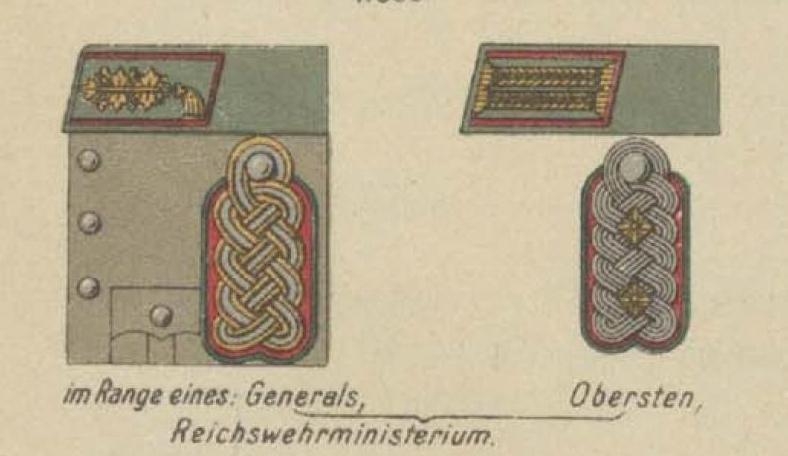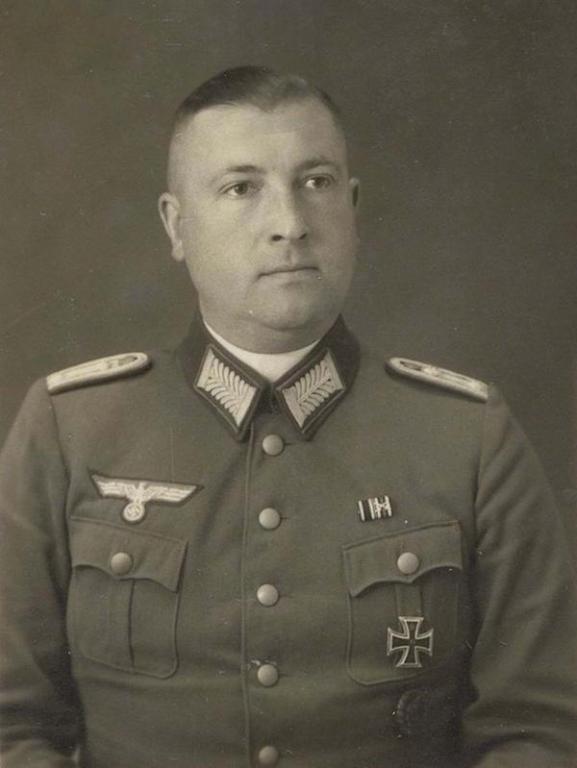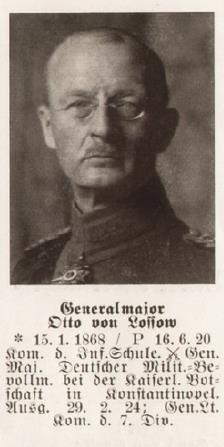-
Posts
2,234 -
Joined
-
Last visited
-
Days Won
55
Content Type
Profiles
Forums
Blogs
Gallery
Events
Store
Everything posted by Glenn J
-
A nice photograph indeed. The Heeresmusikinspizient was still classed as a military official until 1 April 1938 when he was reclassified as a active soldier with the rank of Obermusikinspizient. Here is a later portrait showing him wearing the 1935 pattern Kolbenstickerie of the higher career officials. Interestingly, Professor Schmidt's predecessor, Oskar Hackenberger, although also an official,. wore the collar patches of an Officer of the Reichswehr Ministry. Note the un-piped collar patches. The boards of the GFP official (if that is what he is) are strange. It is difficult to ascertain whether that is a cypher and one star or two stars. The Feldpolizeiassistent wore two stars with the GFP cypher in the centre. There was no one star NCO equivalent rank. So, he either missing the cypher or presumably is not GFP. Regards Glenn Edit, just a thought: there appears to be something in a darker colour nearer the button end of the board (more clearly seen on the board on his right shoulder). Has the cypher been incorrectly applied or even a darker coloured star?
-
Hi Laurence, not sure whether you are monitoring this thread after 11 years!! Hermann Jacob, born 3 April 1873 was a former Prussian Intendantur official with the rank of Ober-Intendantur-Sekretär. Entered military service in 1894 and substantively appointed to the grade of a Militär-Intendantur-Sekretär on 12 December 1905 and in peacetime was on the Intendantur staff of VII. Armeekorps in Münster. He served in WW1 initially with the Governement Intendantur of Namur until September 1915 and then in the War Ministry. Granted the title of a Ober-Intendantur-Sekretär on 27 December 1915, he switched career tracks and was appointed a Geheime Expedierender Sekretär in the War Ministry on 1 April 1918. Restyled post-war as a Ministerialamtmann with seniority of 1 April 1918. He finally appears in the 1938 Wehrmachtbeamte Dienstaltersliste as a Amtsrat (pay grade A2d) with the same date of seniority although oddly his name is spelt as Jakob. Presumably retired shortly thereafter. He was still listed as an Amtsrat in the 1942 Berlin address book. With regards to the collar patch. I think you can discount the first example as officials of the rank of Amtsrat were members of the elevated career. The second example very much accords with the regulations of 22 December 1920 concerning the Bekleidung und Ausrüstung des Reichsheeres as published in the Heeresverordnungsblatt issue of 24 December 1920. The illustration is from annex (Anlage) 2 to this order showing the insignia of Heeresbeamte. Described as "The embroidery of the officials of the former Prussian War Ministry". The only subsequent pre-war alterations to collar insignia of the War Ministry/OKH/OKW concerned members of the higher career with the 1930 and 1935 patterns of Kolbenstickerei. Regards Glenn
-
This from the official order introducing the insignia (Der Rw. Minister, 11.3.30. Nr. 315/3. 30 V 3. Official of the higher career of the Reichswehr Ministry and its subordinate departments/headquarters/staffs wear a golden "Kolbenstickerei" of a special pattern instead of the previous double Litzen and embroidery. I look forward to seeing your pictures and agree with the sentiment regarding contribution by other members. Regards Glenn
-
No, this pattern of Litzen had been worn by all officials of the higher career since 11 March 1930. In fact, the Nebenfarbe on the collar patch looks very dark (black?). Pity we don‘t have his name. Why they were changed? Your guess is as good as mine. Just a periodic change in fashion? Regards Glenn
-
My pleasure. I don‘t attach too much importance to a lack of HV device on these early photographs. Note that Kriegsgerichtsrat Dr. Boetticher above is not wearing the device either. As I mentioned earlier, there were no high grade career Hauptmann equivalents in the Reichskriegsgericht and the pattern of collar Litzen had long been replaced by the two rowed variant. Regards Glenn
-
Hello Meyszner, thank you for your post and the interesting extracts from the regulations. The photograph is superb but I have to disagree with the assumption that he is a Reichskriegsgerichts-Oberinspektor. That does not work on a number of levels: The official is wearing the collar insignia of an high grade career official, the Oberinspektor belonged to the elevated career. There was no category of official at the Reichskriegsgericht in the higher career with the rank insignia of a Hauptmann. The insignia for officials of the newly formed Reichskriegsgericht was introduced per order of 31 October 1936. The collar insignia in the photo was replaced over a year previously per order of 10 September 1935. If he is indeed an army military justice official, he holds the rank of a Kriegsgerichtsrat (less than three years in post from initial appointment) or that of a Kriegsrichter. Regards Glenn
-
below, a portrait of a senior Wehrmachtbeamter auf Kriegsdauer (a.K.) or wartime official. Technischer Kriegsverwaltungsrat Dr. Georg Ufer wearing the 21 March 1940 pattern insignia of an official in the high grade career with the rank insignia of a major. TKVR Dr. Ufer was a military geologist. The order stipulated that officials in this rank of the age of 40 and above wore the insignia of a Major, those below that age, that of a Hauptmann. The 21 March 1940 order further stated that the uniform of Wehrmachtbeamte a.K. was analogous to that of the Kriegsverwaltungsbeamte (with some differences in insignia). That being the case, collars and cap bands should heve been of a blue/grey colour. Photographic evidence would suggest that this was rarely implemented. Regards Glenn
-
I thought it might be nice to resurrect this super thread after five years of inactivity. I was recently looking at the career structure of military justice officials and happened across this fine portrait of the then Kriegsgerichsrat Dr. Hans Boetticher at BA-MA. Of particular note in this portrait are the early pattern (pre 10 September 1935) Höherer Dienst collar patches. The later Generalrichter Dr. Boetticher was appointed as a Kriegsgerichtsrat on 28 March 1935 effective 1 March 1935. As per the 22 December 1934 regulations, he would wear the rank insignia of an Hauptmann for three years before being granted permission to adopt those of a Major. Interestingly, in the case of Dr. Boetticher, he was promoted to Oberkriegsgerichtsrat (Oberstleutnant) on 6 February 1937 with seniority from 1 February 1937. By the strict application of the regulations, therefore, he would have swapped his captain's boards for those of a lieutenant-colonel! Promoted to Oberstkriegsgerichtsrat (Oberst) effective 1 September 1939, he rose to the rank of Chefrichter (Generalmajor) on 1 November 1942. This rank pretty much appears to be ignored in the literature concerning Wehrmachtbeamte uniforms but numerous army and Luftwaffe justice officials were promoted to this rank on 1 October 1942 with subsequent further promotions of officials to this rank until the formation of the Truppensonderdienst in May 1944. I am assuming the badge of rank was that of a Generalmajor with green underlay and a light blue secondary "Nebenfarbe." Regards Glenn
-
I cannot confirm the extent or nature of his pre official military service. Once appointed aa an official however, he was no longer in the position to gain further long service awards. Officials were neither eligible for the officers' long service decoration and in his case nor the Landwehr long service decoration as he was not a reserve or Landwehr officer. Regards Glenn
-
He served much longer than that. He was substantively promoted to the rank of Kasernen-Inspektor on 22 December 1873 having previously held the rank of an "interimistischer Kasernen-Inspektor" prior to his promotion. In the Prussian army Ranglisten only the heads of establishment of Garrison administrations, Proviantämter etc. were listed explaining his non listing in that publication until 1883. Born in 1824, he presumably was also an ex regular Prussian army senior non commissioned officer. He retired on 9 July 1894.Died 8 January 1907. Regards Glenn
-
Jon, unfortunately, I don't have an image of Baron Karl. Interestingly Baron Max was granted the Charaker of a Generalleutnant on 18 June 1914; this being the occasion of the centenary of the 1. Schweren Reiter-Regiment Prinz Karl von Bayern. As you surmise, it does not appear he served in any capacity in WW1. Regards Glenn
-
David, his entry in the Stammliste of IR 21 is more detailed. Just as an aside, one has to be a little careful with the numbering of the early Füsilier regiments. Although Herr von Motz with the then 34. Infanterie-Regiment, this became the 35. Infanterie-Regiment in 1820 and consequently he is listed in the FR 35 Stammliste! He merits just two lines in the IR 87 Stammliste. Regards Glenn
-

HANS VON SEEKT MEDAL BAR
Glenn J replied to filfoster's topic in Wehrmacht Medals, Decorations & Awards
well chaps, it appears he did; granted permission by the Führer and Reichs Chancellor permission to accept and wear the Großkreutz des chinesischen Jade-Ordens dated 21 October 1936 Whether he got around to wearing it is debatable; he died a couple of months later. Regards Glenn -
Hi Jon, it appears so but one assumes that he was not allowed by seniority rules to be substantively promoted over more senior colonels. Interestingly, it is claimed in "Die Generale des Heeres 1921-1945" that he received a Patent as a Generalmajor of 14.12 17. This is not reflected in the 13 April 1918 Rangliste of which you provided an extract nor is it gazetted in 1918 and 1919 editions of the Bavarian Kriegsministerial-Verordnungsblatt. He was already a Generalleutnant in the first DIenstalterliste I have seen postwar (1922) but his Patent date as a Generalmajor is shown in the publication "Die Führer des Reichsheeres 1921 und 1931" (see attached). Regards Glenn
-
Jon, and you would be correct to do so. 🙂 You are just misreading the Rangliste. General von Lossow is listed after all the generals with a Patent, the last of which had seniority from 14 December 1917. General von Lossow had no Patent at this time and is consequently the next in line. He received his patent post-war in the Reichsheer: 16.6.20. Regards Glenn







